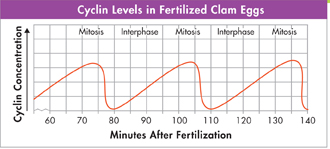Analyzing Data
The Rise and Fall of Cyclins
Scientists measured cyclin levels in clam egg cells as the cells went through their first mitotic divisions after fertilization. The data are shown in the graph.
Cyclins are continually produced and destroyed within cells. Cyclin production signals cells to enter mitosis, while cyclin destruction signals cells to stop dividing and enter interphase.
Interpret Graphs How long does cyclin production last during a typical cell cycle in fertilized clam eggs?
Infer During which part of the cell cycle does cyclin production begin? How quickly is cyclin destroyed?
Predict Suppose that the regulators that control cyclin production are no longer produced. What are two possible outcomes?
Apoptosis Just as new cells are produced every day in a multicellular organism, many other cells die. Cells end their life cycle in one of two ways. A cell may die by accident due to damage or injury, or a cell may actually be “programmed” to die. Apoptosis (AYP up TOH sis) is a process of programmed cell death. Once apoptosis is triggered, a cell undergoes a series of controlled steps leading to its self-destruction. First, the cell and its chromatin shrink, and then parts of the cell's membranes break off. Neighboring cells then quickly clean up the cell's remains.
Apoptosis plays a key role in development by shaping the structure of tissues and organs in plants and animals. For example, look at the photos of a mouse foot in Figure 10–15. Each foot of a mouse is shaped the way it is partly because cells between the toes die by apoptosis during tissue development. When apoptosis does not occur as it should, a number of diseases can result. For example, the cell loss seen in AIDS and Parkinson's disease can result if too much apoptosis occurs.

FIGURE 10–15 Apoptosis The cells between a mouse's toes undergo apoptosis during a late stage of development. Predict What is one way the pattern of apoptosis would differ in foot development for a duck?
Table of Contents
- Formulas and Equations
- Applying Formulas and Equations
- Mean, Median, and Mode
- Estimation
- Using Measurements in Calculations
- Effects of Measurement Errors
- Accuracy
- Precision
- Comparing Accuracy and Precision
- Significant Figures
- Calculating With Significant Figures
- Scientific Notation
- Calculating With Scientific Notation
- Dimensional Analysis
- Applying Dimensional Analysis





